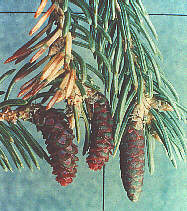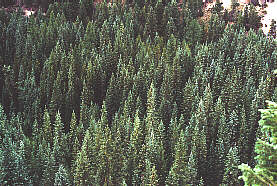

Picea glauca also known as Canadian Spruce, Eastern Spruce, Black Hills Spruce, Skunk Spruce, Cat Spruce, Engelmann Spruce
White spruce is one of farthest ranging conifers in North America. It is one of Canada's widest ranging and most commercially important tree species. White spruce is a characteristic tree of the Boreal Forest, although it can be found almost everywhere in Canada.
This hardy tree survives in a variety of climates and sites. White spruce tolerates shade, but grows best in full sunlight. In a hardwood stand, white spruce will survive as understorey trees for up to 50 years. When the competing shade trees die or are removed, they grow at a faster rate. In conifer stands, white spruce will often become the dominant species as the stand ages.
Aboriginal people in North America used white spruce's strong pliable roots to make lacings for birch bark canoes. They also used the gum (a sticky substance that leaks through wounded bark) for waterproofing the birch bark seams.
White spruce is a main source of pulpwood and construction grade lumber. Its long, tough fibres produce superior pulp, which is made into a wide range of papers, fibre moulded products, insulating boards and particleboard.
The wood is lightweight, soft and moderately strong. It is used for boards, planks and joists for construction, boxes and crates, doors, roof decking and paneling. The wood is also prized for use in piano sounding boards, violins, paddles and oars.
White spruce provides food and shelter for many species of wildlife. The tree's abundant seeds are an important food source for birds and small mammals.
Every two to six years, white spruce trees bear massive cone crops that produce more seeds than the seed eaters can consume. This helps the tree to reproduce successfully. White spruce also provides good winter cover for martens, fishers, voles and snowshoe hares.
How to Identify White Spruce
Tree Shape
White spruce are medium-sized trees with single, straight trunks that end in thick, uniform, conical crowns. The lower branches droop or extend to the ground. In dense forests, the lower branches are gradually lost as the trees compete for light.
White spruce can live 300 years and reach heights of 25 to 30 metres and diameters of 60 to 90 centimetres.
Leaves
White spruce needles stand out from all sides of a twig in a spiral arrangement. They are 0.5 to two centimetres long. They are stiff, four-sided, bluish-green and produce a pungent odor when bruised.
Twigs
The hairless twigs are whitish-grey to yellow. The small, woody bases, which remain when the needles fall off, leave the twig roughly studded with small bumps.
Buds
The outer bud scales are pointed and do not extend beyond the tip of the bud.
Bark
The bark is thin and scaly. The outer bark is a light greyish-brown. The inner bark is silvery-white.
Cones
White spruce cones are about five centimetres long, slender and cylindrical. When they open the close-fitting, light-brown scales spread to almost form right angles with the cone.
The cones mature in one season. They open in late summer or autumn, and fall off the tree in winter or the following spring.